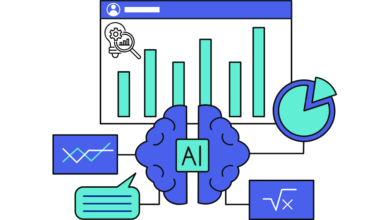
Money laundering is a multi-billion-dollar industry that costs the world two to five percent of its GDP. It also costs banks billions of dollars in fines. In the digital world, financial fraud is the most common crime. Criminals and rogue political groups funnel their illegal funds in greater quantities through legitimate financial institutions, and those institutions typically lack the tools to respond properly.
It’s no wonder, then, that the anti-money laundering software market is projected to reach $1.77 billion by 2023. Financial institutions are serious about avoiding the increased penalties and fines for control failures. Fortunately, artificial intelligence (AI) and machine learning technologies can be used to help in the fight against money laundering.
The downside is that many of these so-called AI/ML solutions aren’t using true AI. Rather, it’s just window dressing on old, outdated approaches. Financial institutions need a solution that really harnesses the ability and power of ML/AI to combat AML.
The imperative has increased with the passage of the U.S. Anti-Money Laundering Act of 2020, the most consequential anti-money laundering legislation passed by Congress in decades. In addition to increased penalties for violations, it also includes enhanced protections for whistleblowers and increased authority for U.S. regulators to seek documents from foreign financial institutions, among other provisions.
Increased regulations
The pandemic and its shift to remote work changed the cybercrime landscape. It created new opportunities for money launderers and financial criminals. Financial services organizations were forced to conduct more of their business online, and the new global home workforce created additional opportunities to exploit financial and enterprise cybersecurity weaknesses. The combination of governmental financial support and increased online and remote banking has led to a spike in financial fraud and associated money laundering.
Non-compliance has also become more expensive during this time, as fines levied against banks for AML violations continue to increase. U.S. banks were hit by $14.2 billion in fines in 2020, the bulk of which was for AML violations. The Anti-Money Laundering Act of 2020 ushers in a new era of anti-money laundering enforcement and regulation for financial institutions in the U.S. With these new rules in place, including the potential for enhanced sanctions and fines, financial institutions have a new imperative to take AML seriously.
Standard AML won’t do
Money laundering continues apace, even though the finance industry spends a huge amount of money on AML solutions. In 2019 Lexis Nexis Risk Solutions researchers found AML compliance across U.S. and Canadian financial services firms cost $31.5 billion.
The study also found that a layered approach is more successful – especially ones that entail ML/AI. And yet many firms are still relying on manual efforts when it comes to AML compliance, which isn’t optimal for performance or cost.
Standard AML solutions get bogged down by false positives. That requires a legion of investigators who spend 99% of their time looking at completely normal financial behavior. Fortunately, the AI revolution can help with this challenge.
Mapping behaviors
The market offers many anti-money-laundering solutions based on AI/ML that rely on a technique called supervised machine learning. Essentially, the AI is given a history of things that are true, and then they try to find new examples. A classic example is cat recognition. You show the AI many photos of cats, and you show it photos that are not cats, and then it learns – so it can identify a photo as “cat” or “not cat.” But in real-life situations involving crime, it’s not so cut-and-dry when it comes to identifying what is a crime and what is not.
The criminals who succeed are the ones who get good at hiding, so what financial institutions need is a more sophisticated type of AI that can enable the mapping of behaviors within a system.
For example, think about a bank with 10 million customers, all conducting thousands of transactions per year. Customer A sends money to Customer B, and Customer B sends money to Customer C, and so on. There are many different types of transactions in different amounts and lurking within all of that is money laundering no one can find. It’s impossible to know what you are looking for in advance.
Financial institutions can begin to find the hidden pockets of crime by using the right blend of techniques. First, it’s key to learn and map all of the different types of behaviors associated with your different customers. ML technology is available today that can learn money flow and financial behavior and compare all the different customers’ behaviors to each other, which reveals pockets of higher risk behavior in a natural way.
The banks’ historic view of risk (based on investigation outcomes) can be overlaid on this map enabling the system to “focus” on particular areas and generate alerts. The map can also be used to learn all the different changes of behavior that occur, for example, the changes in an account behavior between a student account in their final year at university to when they get their first paycheck might be a behavior that occurs many times in the data and can be learned as “normal.”
If it can learn all the normal changes of behavior, then it can identify strange changes in behavior such as a student account going dormant and then waking up again and behaving like a small money transfer business, which could indicate money mule behavior. The key thing here is that none of this relies on rules or scenarios or knowing what to look for – it is learned from the data and adapts as new behaviors emerge.
This kind of automated solution supports the regulatory review and achieves a high level of performance in accuracy, efficiency, and risk coverage – providing a new baseline for the true levels of financial crime. It also provides an industry-first global view of behavior and risk to support the evolution to a truly risk-based approach to AML.
Serious about fighting crime
Some estimates put money laundering at not just billions but up to $2 trillion per year. It’s a highly lucrative enterprise, and so are AML solutions. Machine learning and AI are becoming more prominent in AML solutions, but not all ML and AI are created equal.
Financial institutions must do their due diligence as they research AML solutions; those that can automatically map behaviors are worth further exploration. AI is an effective partner in the fight against financial crime, reducing the risk of fines and saving human resources in the process.




